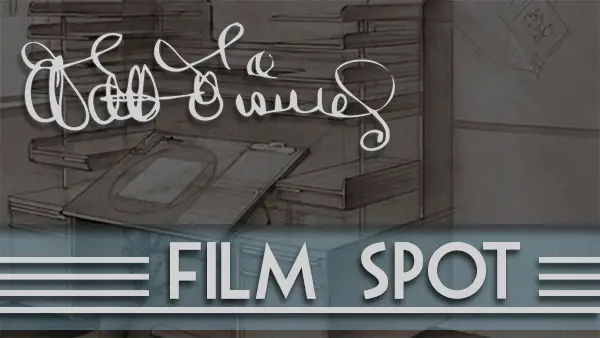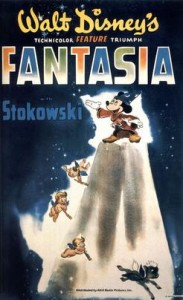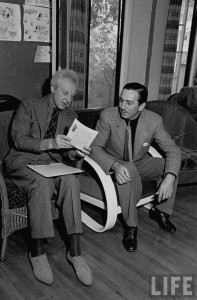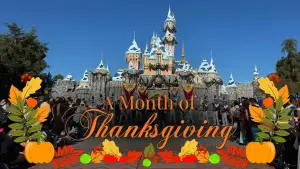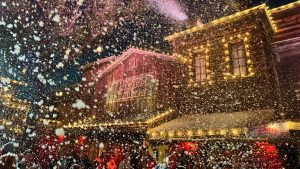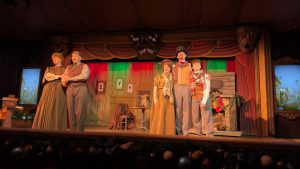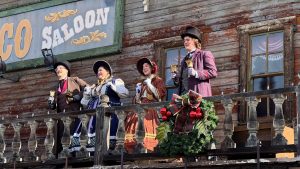Fantasia is an interesting film in that it came right after Snow White and Pinocchio and set out to be so different from the usual Disney product that nobody really knew what to make of it. An entire feature-length film devoted to classical music? Coming off the Great Depression and in the midst of World War II, it was no wonder that people were confused by the movie. It just wasn’t something they were expecting from Walt Disney Studios – an almost high-brow east coast art film aimed at classical music and fine art enthusiasts, the majority of whom were wealthy socialites.
However, we regard Fantasia today as one of the greatest American films of all time, not only because of its immense artistic experimentation, but because it was the first and only time that Disney had the freedom to work outside the typical boundaries of the standard Hollywood narrative. Instead of a straight film with a beginning, middle, and end, Disney sought to abstractly depict the emotions and gravitas of the musical form through different aspects of nature and history.
Let’s go back to 1940. Walt Disney wanted to revive the career of Mickey Mouse, whose animated shorts were dwarfed (pun intended) by the sheer magnitude of his feature films. Though they were still popular with audiences, Disney wanted to widen the scope of the character and bring him up to feature film level. His decision to sync The Sorcerer’s Apprentice with original music hearkened back to the early Silly Symphonies days, though now Disney wanted to go beyond the usual slapstick, gag-driven humor into a more complex, epic form of storytelling. He wanted the level of fantasy intensified, multiplied, and the only way to do that was to bring in an experienced classically-trained conductor.
Enter Leopold Stokowski, conductor of the Philadelphia Orchestra, amongst other organizations. Walt Disney met him at a restaurant in Hollywood and they hit it off. In fact, Stokowski was quite serious about committing to Fantasia for no cost, and they immediately began gathering up the necessary craftsmen. When the Sorcerer’s Apprentice short ran over-budget, they decided to incorporate other musical pieces and create even more high quality short films, putting them together like a concert feature and creating an entire feature film. This began Disney’s practice of package films which multiplied throughout the 1940s.
The pieces chosen for Fantasia came from masters of classical music: Bach, Tchaikovsky, Beethoven, Stravinsky, Dukas, Ponchielli, Mussorgsky, and Schubert. Much can be said about the visual images that accompany the music – that Rite of Spring was a powerhouse of immense images telling the story of the creation of Earth, and the touchiness surrounding the themes of creationism vs. evolution, that The Pastoral Symphony was subjected to enforcements by the Hays Code and the later controversies surrounding the depiction of the centaurs, the terror and hellish quality of Night on Bald Mountain, and the beauty and majesty of Ave Maria.
I would be remiss if I failed to mention the sequel six decades in the making, Fantasia 2000. In 1940, Walt saw Fantasia as the first in a series of animated concert features, with each subsequent film tackling a different style of mus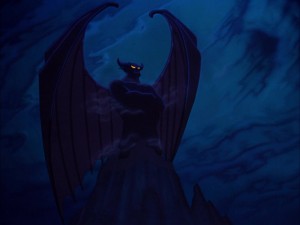 ic. Though the commercial failure of Fantasia brought an end to those plans, he did create lesser films in the same vein (Make Mine Music, for example), but none of them compared to the triumphant pièce de résistance that was Fantasia. Enter Roy E. Disney, nephew of Walt Disney, and the man in charge of Disney Animation throughout the 1990s. As the torchbearer of the Disney family legacy in the company, Roy Disney sought to reignite the ideas scrapped after Fantasia. He made Fantasia 2000 his pet project and, with sleeves rolled up, meticulously produced the film. Whereas Fantasia was an ode to 19th century classical music, Roy Disney sought to update Fantasia with the American Dream. By updating the theme of Fantasia 2000 to 20th century Americana, most notably with George Gershwin’s Rhapsody in Blue, an ode to the New York culture.
ic. Though the commercial failure of Fantasia brought an end to those plans, he did create lesser films in the same vein (Make Mine Music, for example), but none of them compared to the triumphant pièce de résistance that was Fantasia. Enter Roy E. Disney, nephew of Walt Disney, and the man in charge of Disney Animation throughout the 1990s. As the torchbearer of the Disney family legacy in the company, Roy Disney sought to reignite the ideas scrapped after Fantasia. He made Fantasia 2000 his pet project and, with sleeves rolled up, meticulously produced the film. Whereas Fantasia was an ode to 19th century classical music, Roy Disney sought to update Fantasia with the American Dream. By updating the theme of Fantasia 2000 to 20th century Americana, most notably with George Gershwin’s Rhapsody in Blue, an ode to the New York culture.
Fantasia was an experiment in different methods of storytelling and all the failures and success that came with Fantasia served to enhance Disney’s understanding of the art form. Over a thousand artists and technicians worked on Fantasia, which would go on to become an artistic masterpiece. Walt Disney had accurately recreated the concert experience using the medium of film and, despite the initial mixed reaction, the studio single-handedly proved that the movies were a worthy artistic competitor to the high-brow plays and concerts of the East Coast.

